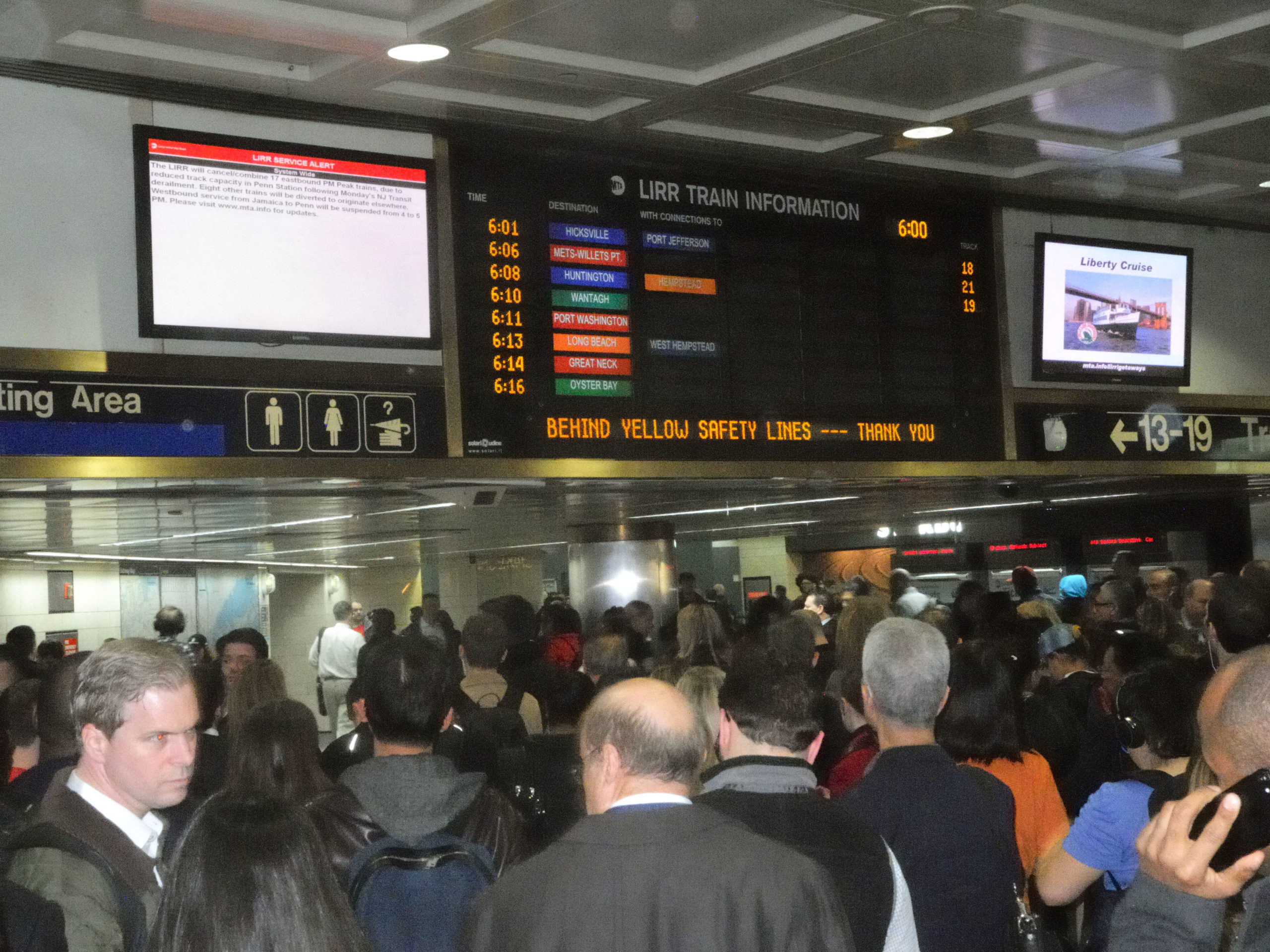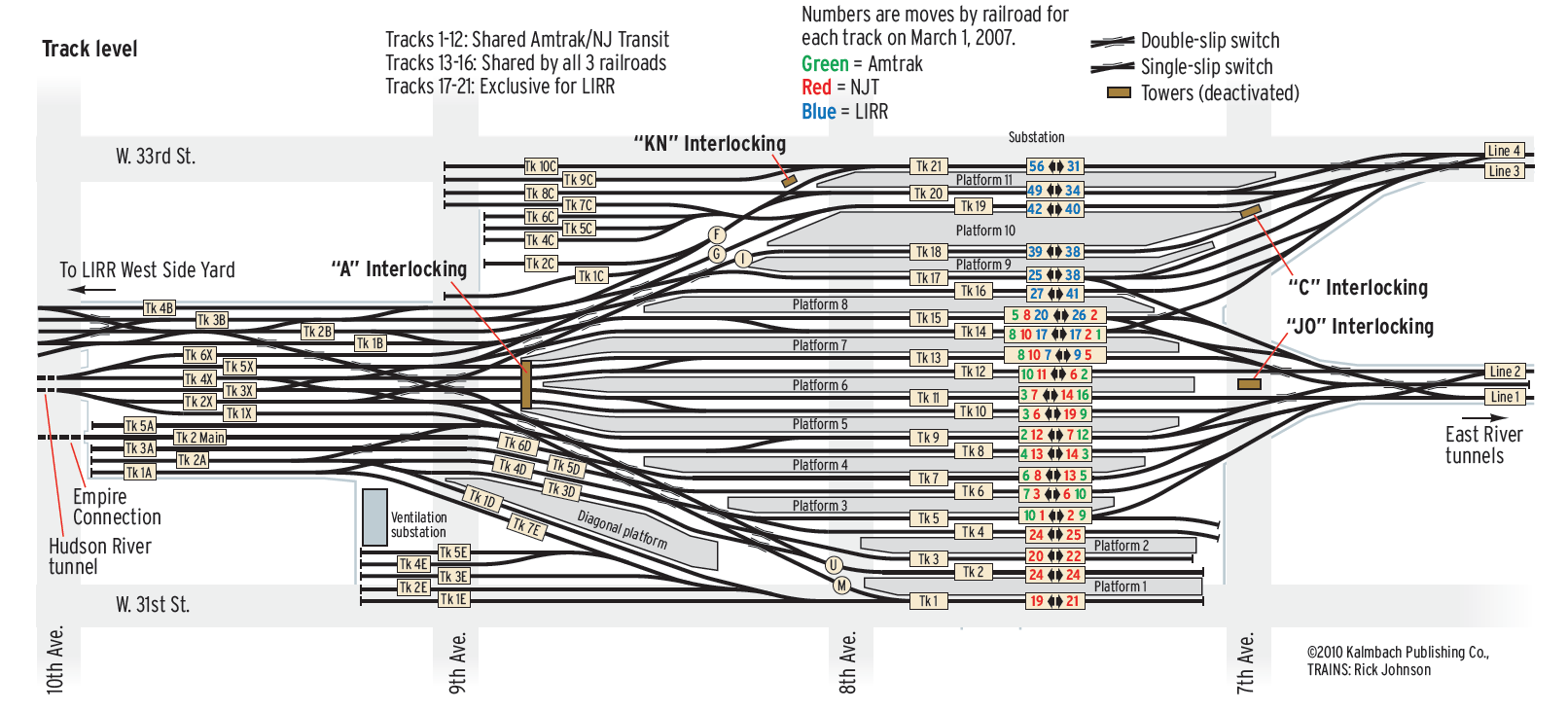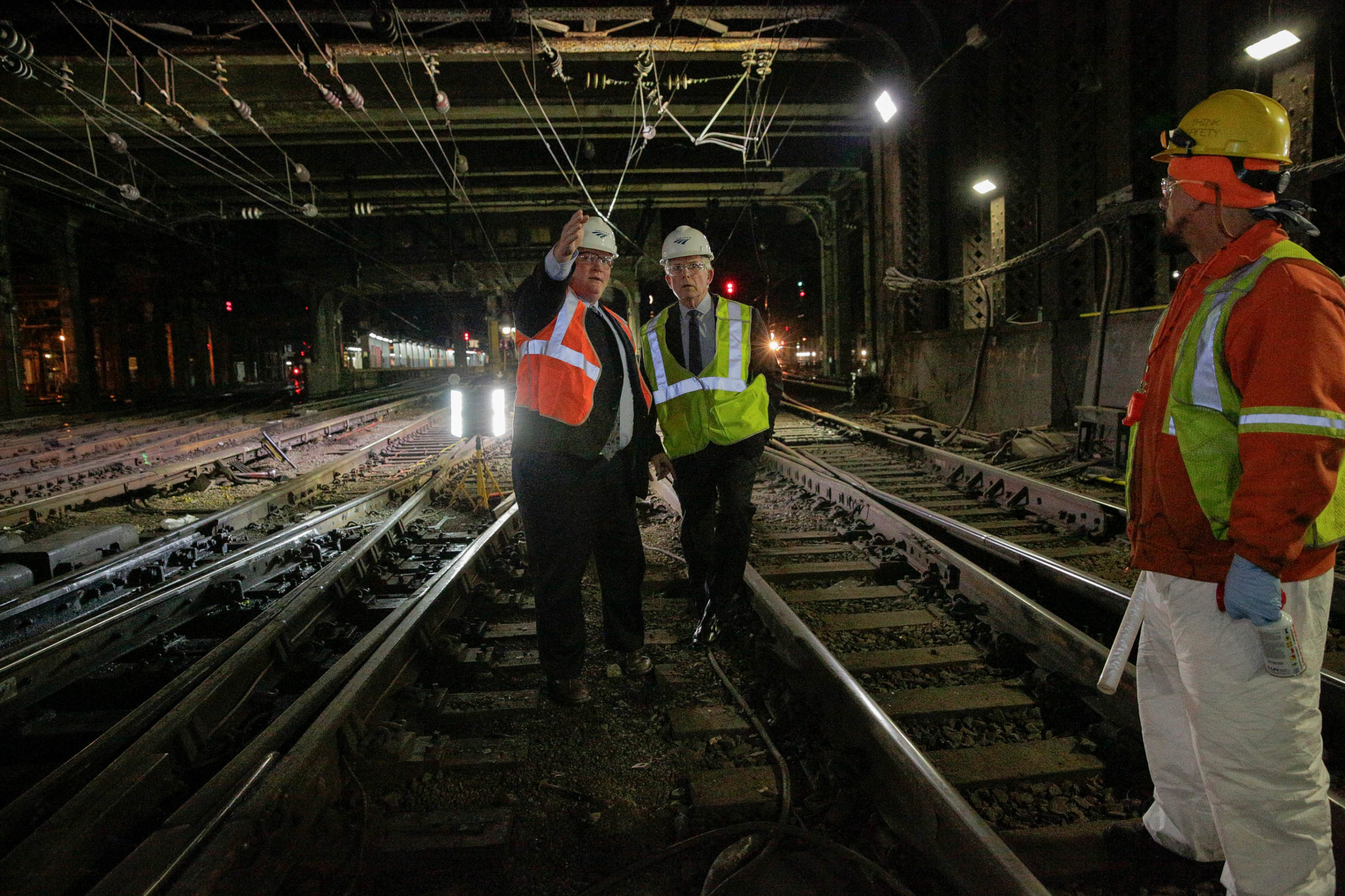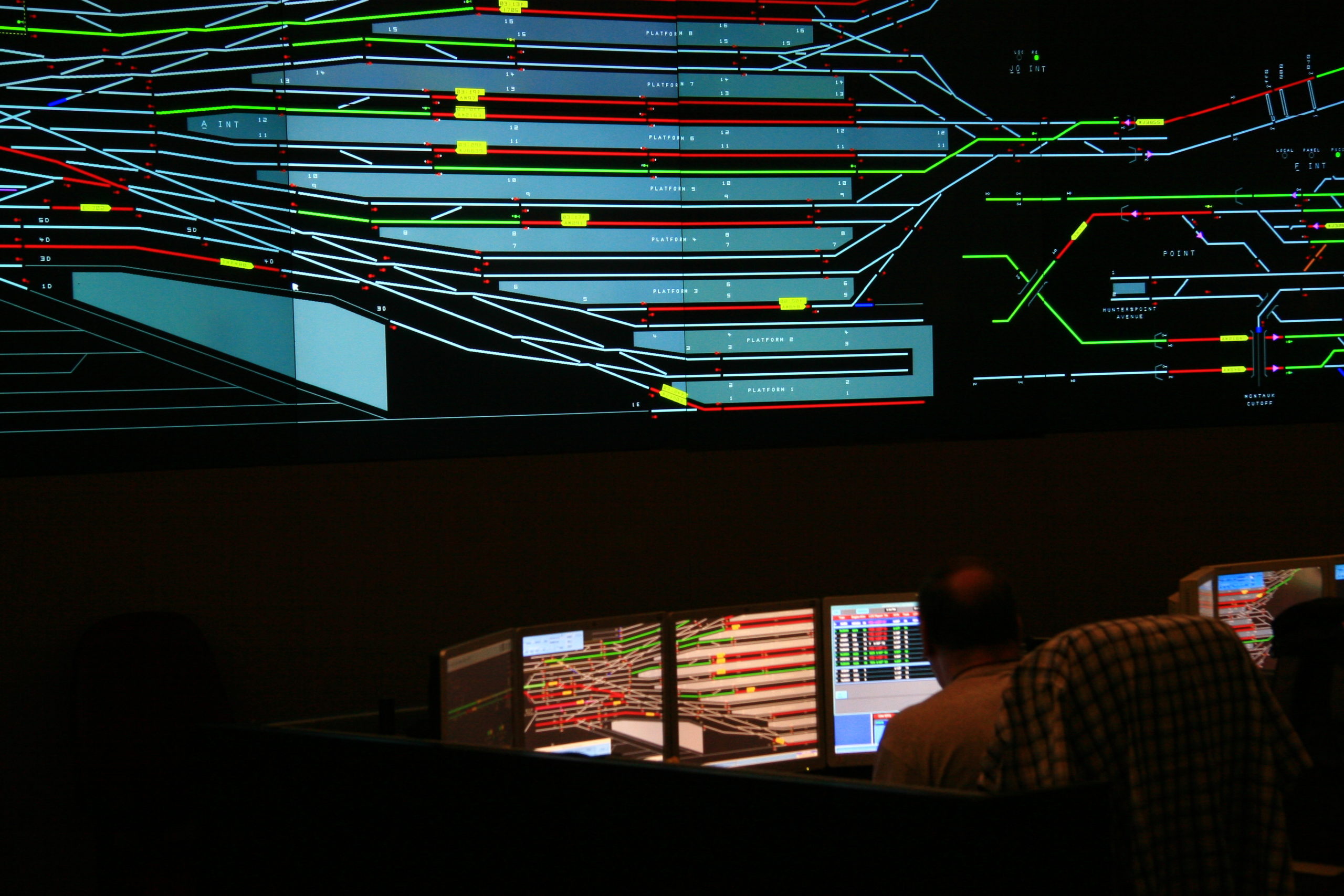Specifically, Moorman pinned the blame for a three-car April 3 derailment of an inbound NJ Transit train on a wide gauge due to defective wood ties. He said mismatched rail on a curve caused an Acela Express to sideswipe an NJ Transit train on a curve on March 24.
The incidents occurred on rails leading to tracks 9 and 6, respectively, at the southeast corner of the station. Any train headed to or from the Hudson River Tunnels or the Empire Connection that uses station tracks 1 through 9 must pass through switches across one of two “ladders” that are constantly busy.
Stub-ended tracks 1 through 4 are reserved for either NJ Transit equipment or Amtrak’s New York-Harrisburg push-pull Keystone Corridor trains. Because both services can reverse in the station, they don’t eat up valuable through-track capacity needed for trains which must travel through East River Tunnels to access Sunnyside Yard.
An added limitation is that all Empire Service trains and the Lake Shore Limited can only use tracks 5 through 9. The connection to an ex-New York Central freight line was built in 1991 when all Amtrak operations moved out of Grand Central Terminal.
Thus, many Keystones and Empires were cancelled while trackage was being repaired following both derailments; some Keystones reversed at Newark, N.J., where passengers could catch Port Authority Trans Hudson trains into Manhattan and a few Empire Service round-trips connected with Metro North at Poughkeepsie or Croton-Harmon, N.Y.
Even though Long Island Rail Road trains don’t typically traverse interlockings where both derailments occurred, its operations were impacted by reduced platform options for Amtrak and NJ Transit trains needing to get to Sunnyside for servicing.
According to Moorman, only after the April 3 mishap did Amtrak, “survey all other sites at the station that could possibly have the (misaligned rail) condition, and we can confirm that none were found.”
He adds, “We have changed our specs to eliminate the mismatched condition” which caused the March 24 Acela Express-NJ Transit sideswipe.
At the press briefing, Moorman acknowledged, “we had notations that the (defective ties) needed to be replaced…at that location and others” as a result of regular inspections, “but we clearly did not have the understanding that there was an imminent failure.”
Replacing ties, ballast, and rails on tracks as busy and interconnected as those that serve the throat of Penn Station requires an engineering supervisor to forcefully make the case to operations people — here not only at Amtrak but also with NJ Transit and Long Island Rail Road personnel — that tracks must be taken out of service for a period of time long enough to make repairs.
Amtrak does this every weekend when it closes one of the two Hudson River tunnels for maintenance. Saturday and Sunday schedules are adjusted so most westbound trains leave Penn Station between the top and bottom of each hour, while eastbounds are fleeted from the half-hour to the next full hour.
Taking multiple tracks out of service for an extended period for repairs at Penn Station, as the disruptions last week illustrated, could require advance rescheduling that would have to be coordinated among multiple agencies so travelers could be notified.
Moreover, to do it as fast as possible in an off-peak period would demand amassing an all-hands-on-deck work force being paid time and a half or maybe double time unless management believes repairs could be safely conducted in piecemeal fashion over a longer time frame. That is clearly what happened here, with the prevailing consensus among inspectors betting that relatively slow speed operation would not put undue stress on wobbly infrastructure.
They were wrong.
On paper, the arbiter of whether track repairs must to be done today or can wait until tomorrow is Amtrak’s recently-installed Chief Operating Officer Scot Naparstek, whose direct reports include both engineering and operations. Like any upper level manager, however, his role in maintaining a safety culture impervious to financial pressures is only as good as the information that flows up from the troops.
Moorman says he is “leading a comprehensive review of our maintenance practices and engineering department, including bringing in independent experts, to ensure we have the right processes and organization to maintain and improve our infrastructure.”
Evidently, Amtrak senior management has let a wealth of institutional knowledge slip away that helped prevent Penn Station track failures in the past. With retirements, some loss is inevitable, but the pace picks up when presidents continuously shuffle the deck. Perhaps what’s needed now is a hands on “czar” who insists on absolute compliance with the safest strategy possible. And that person needs to be Wick Moorman.


















MR. DECAMP: Obvious solution is to build a station at the wye opposite the zoo. (and call it North Philadelphia?) It is awe-inspiring how this can go without doing or ever being mooted. Explanation found in the business formula which includes promoting long reverse moves and as much circuitousness as possible. Have an interesting proposal for Philly found under “NEC Future? or Backwardation” at rail-nyc-access.com that’s 2-mi. shorter than the existing route.
Mr. Ludwig:
If you mean “direct current”, then d.c. is the correct identifier.
If, however, you mean the federal feifdom known as “The District of Columbia”, and carved out of Maryland land [to which Virginia was supposed to contribute, [but failed to do so and reaped significant real estate profit] benefits, that is normally known as “DC” using the official postal code.
Amtrak still rosters the greatest number of its trains between NYP and PHL. Many go north of NYP, and go south of PHL [or execute strange reversals at PHL to go on to Harrisburg] but those moves are more driven by politics, rather than sound transportation planning.
mr. delaney:
there is all kinds of through traffic at penn station. most acelas and northeast regionals run from
d.c. to boston and back. likewise, there is the vermonter, which begins in d.c. and jogs north
after new haven to northern vermont.
The double ladder tracks with slip switches from 1910 enable high-volume access to the platform tracks that would not be possible otherwise, and will probably have to be removed to accommodate the additional two tracks from the west, along with partial shut-down of trans-Hudson service (despite what the EIS says) to implement the questionable modifications of the 23-years-in-planning Hudson Tunnel Project. I think the deferred maintenance of this maintenance-intensive section is in preparations for the shut-downs that will accompany the Hudson Tunnel Project. Coming from LIC, as soon as tracks start to branch out at Penn, one can’t help noticing where they’re absolutely flat. Could this kind of thing result in the mismatched rail referred to? For a plan that allows double-stack freight to benefit from a new trans-Hudson tunnel, see: rail-nyc-access.com
I would bet that there is a parallel universe where the Penn and the NY Central got marching orders from New York State and collaborated to build a “New York Union Station” instead. 😀
Frankly, I think where we have “failed” is that we have not classified the good care and upkeep of this piece of infrastructure to have clear national defense implications.
Jim: When I had two good legs I walked those 13 blocks twixt GCT and NYP at least a hundred times. Those were good days but GCT was not on my mind in this instance. Due to growth we are long past the time for a third major rail station in Manhattan. I have long advocated a new run-through station in or near the Financial District with NJT tunneling from the west and LIRR from the east. Divert as many trains as possible there from NYP and let Amtrak sink in its own mire.
Why do we insist on stuffing all intercity traffic for New York City into one station? How many stations are in London?
Informative article, thank you.
Daniel ‘: I don’t know how familiar you are with Penn Station NYC and Grand Central Terminal. They are not that close to each other. Hopefully, in a few more years, he says with his fingers crossed, The Long Island Rail Road will be able to go into GCT. You’d think that would solve the problem. WRONG! The MTA wants to send the New Haven Line of Metro North into Penn. Station. Meanwhile, we are waiting and hoping for the Gateway to be funded and built. But Trump wants to cut the funding for the Gateway Project and the Moynihan Station. Until that happens, it will continue to be, S.O.S. D.D. I don’t know if I’ll be around to see this happen.
There used to be two stations – NY Penn and GCT. Penn (PRR, LI and CNJ) served western and southern intercity (plus Boston via New Haven) and NJ and Long Island commuter trains. GCT (NYC and NYNH&H) was western and northern intercity, and upstate NY and Connecticut commuter trains (may have missed some oddities).
GCT still serves commuter traffic for Metro North, but as noted, all of the intercity traffic has moved to Penn, as well as CNJ and LI commuter traffic. GCT is a stub terminal, but Penn is through, although there is little if any through traffic. I have read reports of PRR and LI operating through trains to Montauk and the Hamptons, and to the 1939 World’s Fair. I have seen pictures of LI DD-1s leading PRR GG-1s to the Fair. The GG-1s remained on the train for steam, since the DD-1s were freight engines without steam generators. During WWII, freight trains ran through Penn at night, avoiding the trip up to Albany, or the Bay Ridge car ferry.
good report about a difficult problem Everything mankind makes wears out: cars, airplanes, roads, locomotives, space shuttles, even dental fillings. Any system should have replacement or maintenance budget as part of the acquisition cost. Too often we build the shiny thing and ignore the maintenance requirements needed in twenty years. I am surprised that Penn Station has lasted this long!
One small error in the location of these problems: it is in the southwest and not southeast.
But beyond that, it should be noted that Moorman is just arriving on the scene and what he has found out in his short time is what Amtrak, NJT, and LIRR officials have been screaming about for decades: the plant is old, it needs replacing to get the fixing done. How many have to say it how loud and how often? How many more derailments, inconveniences, and even injuries or death, have to be recorded before Congress and other government leaders will finally get the wax, dirt, and dollars out of their ears and do something? Is Moorman to be the one who succeeds in pushing the message through or will there have to be more problem, or more serious problems?
,
London is the model of how NOT to have intercity train stations. The city stopped RR construction at the city boundary – to their long term detriment.
If you ever had to do the Penn Station/GCT shuffle, you’d know that multiple stub end terminals is a bad idea!